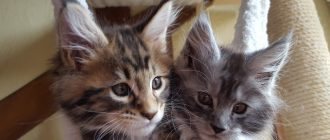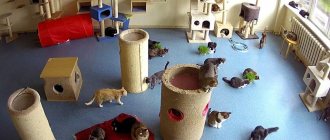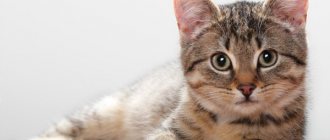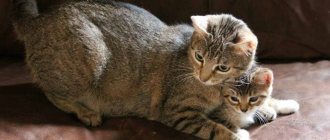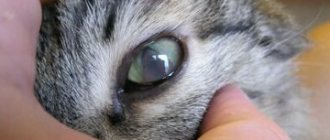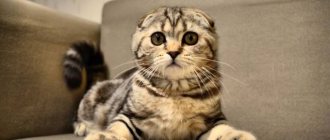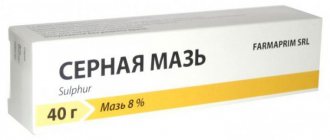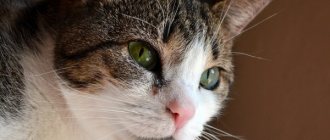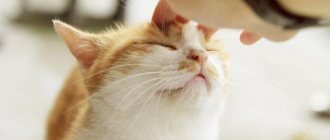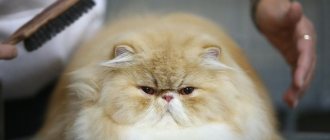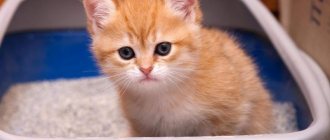In this article we will tell you about some features of caring for pets at home. For example, we know for sure that our patients often have problems with the treatment of sutures after surgery; the animal simply does not allow them to be processed properly. There are also many other problems that ponytail owners face when trying to treat their pet at home.
This is what we will talk about. Topics of this webinar and article:
- — How to properly restrain your pet;
- — Fixation of cats;
- — Fixation of dogs;
- — Trimming animal nails at home;
- — Treatment and cleaning of ears;
- — Cleaning the anal glands;
- - Teeth cleaning;
How to pick up a cat
The cat should be picked up under the chest with both hands. Raising your chest, you should press the back of your chest to the side of your body, right under your elbow. Then you should change the position of this hand and grab the cat under the chest with your palm, and then squeeze the animal’s front paws with your fingers. After this, the second hand will be free. When you pick up a cat in this way, you should definitely scratch its neck, which will calm it down a little. If the cat tries to escape, then by taking it in this way you can grab it by the hind legs.
How to pick up a cat by the scruff
How to pick up a cat by the scruff.
When an owner adopts a cat, their first priority should be to avoid being bitten or scratched. If the cat is calm and very well-mannered, then the owner can limit himself to supporting her head with his other hand, but if the cat tries to escape, this most likely will not help.
The easiest way to restrain a cat is to gather the skin on its neck with your free fingers and then grasp it firmly.
Actually, this is what is called “taking the cat by the scruff of the neck.” Once in this position, the cat may decide to submit to its fate and will not need to be held too tightly. So don't go too overboard and risk hurting your cat.
If you look at the expression on the cat's face, you can conclude that she is not happy with this, but if you do not squeeze your fingers too hard, the cat most likely will not feel pain. The dissatisfied expression is most likely a consequence of the stretched skin on the muzzle. The need to grab the scruff of the neck may also appear when it is urgently necessary to pull it out or catch it from somewhere, for example, when it is hiding, or when it needs to be pulled from a tree.
Bathing and grooming bag
It is also called a bathing net, a bathing bag, or simply a cat swimsuit.
It is useful not only for water procedures, but also for other hygiene measures, as it allows you to partially immobilize the animal.
How to bathe a cat in such a bag
First you need to prepare for water procedures. Add shampoo to the container of water where you will wash the cat and whisk it until foamy. Then place the animal in the net and secure it with strings (laces), first on the neck, and then on the rest.
Material: 100% polyester. Size range – for small cats and kittens (S), for medium sizes (M), for large cats (L).
Well, let's look at the last clamp.
How and what to wear a cat
Using special bags and baskets for carrying a cat, you can achieve the same results as wrapping the animal in a towel.
Such bags were designed specifically so that the cat could be closed with a lock, zipper or other fastener.
In this case, the animal's head may stick out. These bags are very convenient, especially for those owners who have no one to help if they need to hold the cat. You can also use muzzles, which, however, are more like masks that cover the muzzle almost completely. They are made of nylon and are used when it is necessary to restrain or calm an animal during a particular procedure. According to the creators of this invention, if the cat does not see what is being done to it, it will not be nervous. True, this theory is good mainly in words, but in practice it almost never justifies itself.
Cat in a carrier bag.
Cat carrier bag
This is the first thing I want to pay attention to. I would call it a “straitjacket” for cats. Everything is thought out to the smallest detail.
The bag is made of durable material that is resistant to sharp claws. Has four zippers on the sides for paws and a zipper on the top. This allows injections to be given both to any of the limbs and to the withers.
Near the neck there is a collar made of soft material with Velcro. The hole for the tail is also velcro. The bag has handles, which is convenient for transportation, for example, for going to the veterinarian.
This “design” perfectly fixes the animal; it looks like a cocoon. But in any case, you need to hold the “cocoon”, since the bag only limits movement.
The sizes are different: 1-2 kg (S), 2-4 kg (M), 4-6 kg (L) and 6-8 kg (XL). The size is selected according to the weight of the animal. Pay attention to this.
You need to unzip the bag, place the cat in it and fasten the zipper at the top. Then adjust the neck circumference with Velcro. Lastly, at the tail.
By the way, such a retainer bag is also suitable for small breeds of dogs!
Reviews
While preparing this article, first of all I looked at the reviews of this wonderful invention. Only positive ones. The only negative is the price. But I don't consider this a disadvantage. A good and useful thing cannot be cheap.
- ...we once had the opportunity to give an injection to an aging cat at home, it was horror. Once he even escaped with a syringe in his withers...at the clinic the cat was put in a bag. We were surprised... he was calm. No yelling, no scratches, no bites. ...MEDITATIVE STATE!
- ...it’s worth saving the nerves of the cat and yourself... Yes, she was struggling, so we had to hold her and squeeze her so that the doctor would take blood... But overall, this miracle bag only saved us.
- ...why are they not in demand among cat lovers? In vain - a useful thing in the household! Without waiting for advice or a tip to the store, I ordered a “restraint” bag (and a muzzle at the same time)... the Velcro secured the cat securely, and I easily dealt with the impatiens. Now it will be much easier for me to treat my ears/eyes and give injections to “violent and dissenters”
Other advantages include:
- durable material, easy to clean;
- convenient for blood collection;
- holds the animal well;
- saving your cat's and your nerves;
- Suitable for animals of different sizes.
Well, what about those who you can’t even take in your hands!
A well-known method is to remove visibility by throwing a towel over your head. At this moment, cats experience fear and freeze for a while.
But it's easy to throw off the towel. And here a muzzle will help you!
Safety precautions
You should not make the mistake of thinking that if a cat is very calm and docile in its normal state, then it will be just as calm when it is sick or in severe pain. The same can be said about taking especially nasty-tasting pills that can unbalance even a very calm animal. You should never put yourself at unnecessary risk by giving your pet medication without trying to hold it back. It's even worse when the cat is approached face-first without any restraint. We should not forget that cat bites and scratches are quite painful and can cause serious illness. Because of this, being safe is much better than being careless. If a cat scratches or bites its owner, then he should definitely consult a doctor.
Fixing the animal at the reception
At the appointment, the veterinarian must conduct a clinical examination, but not all pets allow this. A veterinarian, even with extensive experience, cannot accurately predict how an animal will behave in a given situation, but the owner, on the contrary, knows and feels his pet.
An appointment is always required
If your animal is calm and adequate at home, then at the reception your friend may change dramatically due to fear or pain caused to him. He will try to escape or attack the treating doctor, because during the examination it is possible that the doctor may cause him discomfort or frighten the animal not only with unexpected research methods, but even with such harmless instruments as a phonendoscope.
With a fixed pet, examining it or carrying out therapeutic and preventive manipulations will go much faster, thereby:
- you will save your time,
- the period of stress in the animal is reduced to a minimum,
- your pet will not cause harm, in the form of scratches and bites, to either YOU or the doctor.
The animal must be securely restrained even for the slightest manipulation. This especially applies to procedures associated with minor pain and where precision is required from the doctor.
The best fixation for an animal is its owner.
However, if the owner cannot properly restrain the animal on his own, our clinic specialists can provide a service for restraining the pet without the participation of the owners.
In dogs, the main instrument of attack, defense and cutting of food is their teeth, but in cats, sharp claws are also a bonus to the measures of defense and attack.
Cats are quite flexible animals, and it can be quite difficult to securely fix them, even with a weight of 3-4 kg.
The psychology of a cat is significantly different from the psychology of dogs in this way. A cat, even being well restrained, will still wait for the slightest relaxation or the slightest carelessness on the part of the fixer, and if she gets such a chance, she certainly will not miss it, causing as much damage as possible to her offender.
“The less chance an animal has to escape, the calmer it behaves.”
. It is necessary to secure the animal well, as it will feel it and will not try to escape. Be careful and careful when restraining the animal. If the grip weakens, the pet can not only run away, but also cause harm to both you and the doctor.
THE better and more correctly YOU HOLD YOUR PET, THE FASTER THE VETERINARY SPECIALIST WILL COMPLETE ALL NECESSARY MANIPULATIONS.
Recording calm animals
Dogs
fixed by the leash, while it is necessary to slightly tilt his head towards the floor. During therapeutic, preventive or diagnostic procedures, the owner is recommended to talk to his pet, stroke and lightly pat him so that he feels under your protection.
The femoral muscle of the dog's elevated hind leg is well suited for intramuscular injection. Subcutaneous ones are carried out in the withers area, first distracting the animal with stroking.
Cats
Fix
the skin fold with the entire palm
, while it is necessary to lightly press the animal against a hard surface. Intramuscular injections - into the right or left thigh, lifting the animal in a canopy. Subcutaneous - in the withers area in the “canopy” position or pressed against a hard surface.
Fixation of excited animals
Excited dogs
put on a muzzle or place a figure-eight loop on the muzzle. Then, the owner fixes his pet's neck by the leash with one hand, and with the other hand supports the dog's chest or stomach, while slightly lifting it.
Cats
put on a muzzle; if there is none, then fix it by a fold of skin in the cervical-behind-the-ear area with one hand. With the other hand, fix both hind legs in the lower leg area.
Do not manipulate in front of your pet's face with your hands.
Fixation of aggressive animals
Dog
At least two people are recorded. They put on a muzzle, fix it by the leash to any fixed support (a machine, a table leg, a water or heating pipe), or lay it on its side or back.
cat
two people fix it. It is imperative to wear a muzzle and place it in a special bag-retainer.
If there is no bag, fixation is carried out as follows
: one person securely fixes the cat by the fold of skin with one hand, and with the other hand fixes the front paws in the forearm area, while the second person fixes the hind paws in the shin area.
A BLANKET OR BLANKET is a “good reliable friend” of the veterinarian and the owner for pacifying obstinate animals.
By throwing a large rag over the animal, you can reliably hide it with what they bite and what they scratch with, then you just need to be able to find the part of the body that is needed for manipulation and examination.
How to wrap a cat in a towel
How to wrap a cat in a towel.
It is known from experience that when the owner tries to carry out even the simplest procedure on a cat’s head, without resorting to outside help, it seems that the cat has noticeably increased strength. It is very difficult to hold her, especially since she can use her claws and even teeth. If a cat needs to put medicine in its eyes, ears or nose, and there is no one to help the owner with this, then the cat should be wrapped in a large towel. As a rule, only the head or one of the paws remains free.
Nail trimming
The rules for trimming claws are determined by the peculiarity of their structure: the insensitive keratin (horny) layer covers the sensitive claw bed (pulp), which has nerve endings and blood vessels. The pulp will be shorter the more often the nails are trimmed. If the pulp is visible, then it is necessary to cut it no closer than 2 mm from its end (in cats, its pink color can be seen in the light). In dogs with black claws, the pulp is not visible, so the claw should be cut into small pieces. If the end of the claw is dry and flaky, then you can cut further. If a dark gray or black circle or oval of the young layer of the claw is noticeable in the center of the cut, then you cannot cut further. Where the pulp ends, the claw is thinner; it is up to the thickening that the keratin cover can be cut off. The cut must be made without jerking or jerking in one neat movement, maintaining an angle of approximately 45 degrees relative to the axis of the floor.
To trim claws, the following tools are needed: nail clippers of various types, a nail file for sharpening (keep in mind that electric files can frighten animals), cotton swabs or disks, hemostatic drugs: dry potassium permanganate, special pencils or sticks.
Typically, a cat is wrapped like this:
- A towel is laid out on the table. The cat, taken by the scruff, is placed in its middle.
- While continuing to hold the cat with one hand, the other hand throws part of the towel over the cat's back and tucks it under its side. In this case, the fabric is stretched quite strongly.
- The other half of the towel should then be wrapped around the cat and only when it is tucked under the cat's body can the scruff of the neck be released. If the cat does stick its paws out from under the towel, then it will need to be pulled tighter.
If you find an error, please select a piece of text and press Ctrl+Enter.
What does a cat owner need to know about anesthesia?
At first glance, the life of our pet is easy and pleasant: she is fed, taken care of, stroked and caressed. However, sometimes the owners come up with strange fantasies. Then suddenly they decide to wash and comb the fur, although it is already carefully licked and smoothed every day. Sometimes they take you somewhere far away, and it’s good if it’s to a dacha, otherwise you suddenly find yourself in some strange room, where there is an eerie smell, barking and meowing are heard, and someone else’s uncle in white is preparing to perform strange actions.
And although the owner speaks kindly, it all looks suspicious, and most importantly, even the smartest cat in the world cannot understand why all this is needed.
How to help a cat so that this help does not become unbearable stress for her? And how can we make it possible to carry out the necessary procedures? In order to answer these questions, let's look at situations where the use of special drugs may be necessary.
